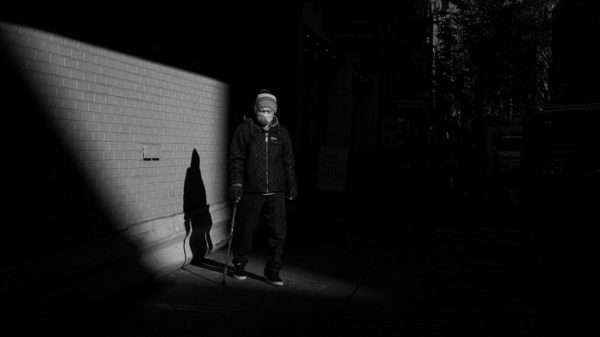Fossil thieves, crumbling bones and large amounts of bird poo were just a few of the challenges faced by the team that uncovered a “sea dragon” in Rutland.
The UK’s largest, most complete, skeleton of an ichthyosaur – an ocean-going reptile from the time of the dinosaurs – was found at Rutland Water was revealed to a fascinated public on Monday.
The discovery, made last February, has been hailed as “one of the greatest finds in British paleontological history“.

But, as conservator Nigel Larkin explains, preserving the 33ft (10m) remains meant overcoming a variety of obstacles – both man-made and natural.
“Because the area is a bird sanctuary, we had to spend most of the first stages shovelling bird poo out of the way,” he said, from his base in Shropshire.
“It remained a hazard throughout the whole three weeks. We had to protect the tools and wore gloves non-stop.”

The whole project was shrouded in a veil of secrecy.
Nearby bird-watching hides were closed as a precaution, due to other threats.
Mr Larkin said: “We knew as soon as people got to hear about this, there was a possibility it could get raided.
“Unscrupulous people might trophy hunt and potentially sell those things online.
“It’s only a minority but we could not afford for this to go public before we had this fossil out of the ground.”

Once the job of clearing the 180 million-year-old fossil got under way, things only got more tricky.
“The bones were the consistency of biscuit,” said Mr Larkin. “You couldn’t pick one up and hand it around, it’s too fragile, especially with some of the bones being so large.
“Had they been completely fossilised and turned to stone, it would have made it harder to dig out but it would have given the individual pieces structural integrity.
“These were in Jurassic clay which started quite wet but baked hard in the sun.
“It fractures quite easily and if the clay cracked, so might the bones.”

The skeleton was exhaustively recorded in a number of ways, including 3D scans, as the position of the bones provided crucial evidence.
In one case, a rear fin was well-preserved but facing the wrong way.
This, along with a kink in the spine alongside, gave rise to suspicions the ichthyosaur may have been scavenged – a theory given weight by the discovery of another ichthyosaur’s tooth nearby.
To protect the bones and the all-important association of the whole skeleton, the decision was made to lift it in large sections, protected by layers of plaster.

But even this was more difficult than expected.
Mr Larkin said: “We were digging in August. We had expected the problems to be sunburn and heatstroke.
“In fact, it was cold and we were downwind of a massive body of water.
“It was so cold the plaster of Paris wouldn’t set at first. Luckily we got a few dry days and the protective jackets went on.”
The two largest pieces – the head and body – weighed a tonne and a tonne-and-a-half and had to be moved using machines.

They were taken to an industrial unit in Shropshire where Mr Larkin will uncover more of the ichthyosaur’s secrets.
“Phase one was lifting the fossil,” he said. “Phase two will be studying all the hundreds of other specimens we found around the site and also opening up and cleaning a couple of the smaller sections of the skeleton.
“This will give us a better idea of the cost of phase three, which is fully uncovering the fossil.
“It’s 10 metres long, but will be cleaned and conserved under a microscope – both the top side and the underside – so it’s no small undertaking.”
Funding for the first two phases came from a number of bodies, including Anglian Water, the Rutland and Leicestershire Wildlife Trust, The Pilgrim Trust, Rutland County Council and the Palaeontographical Society.
But funding for phase three, let alone the permanent display of the find in Rutland, is yet to be secured.
Local MP Alicia Kearns raised the matter of this (“possibly making the find the first ichthyosaur to be discussed in the House of Commons”, as Mr Larkin observed) and the future of the similarly precious Roman mosaic, also recently uncovered in Rutland, with Prime Minister Boris Johnson but received only good wishes.
Discoveries of a Roman mosaic – which changes our understanding of Roman Britain -, and an 180m year old Ichthyosaur, will change Rutland’s fortunes
So I’m working hard to bring the #RutlandSeaDragon home, & ensure we build a phenomenal tourism offer@Dean_R_Lomax @AnglianWater pic.twitter.com/FC93MD7n7G
— Alicia Kearns MP for Rutland and Melton (@aliciakearns) January 13, 2022
Mr Larkin said: “Opening up the field jackets, removing the Jurassic clay and then cleaning and conserving the bones and finally making permanent supports so that the skeleton can be displayed will take about two years.
“Whilst this work is being undertaken, we will be examining the skeleton for any signs of pathology, and studying the contents of the stomach.
“Its permanent home will need to be somewhere quite big, perhaps more than just a room.
“It might need a wing of its own.”
The project was featured on BBC Two’s Digging for Britain, which is available on BBC iPlayer.

Follow BBC East Midlands on Facebook, on Twitter, or on Instagram. Send your story ideas to eastmidsnews@bbc.co.uk.












